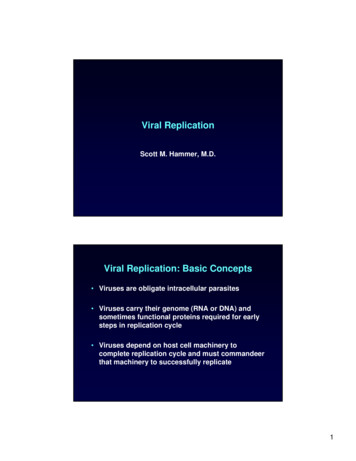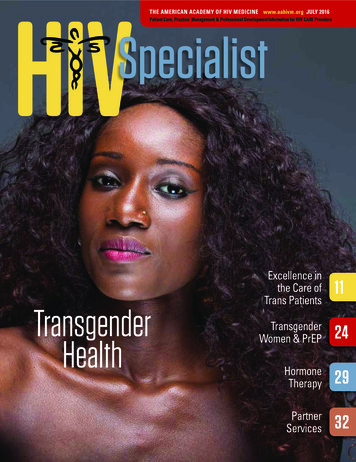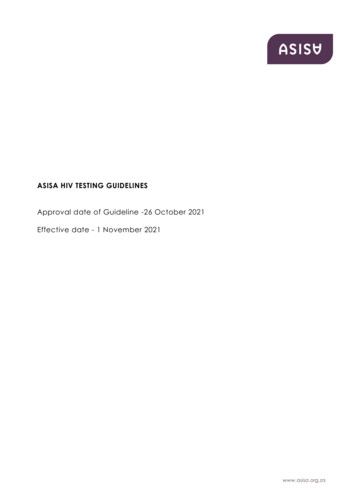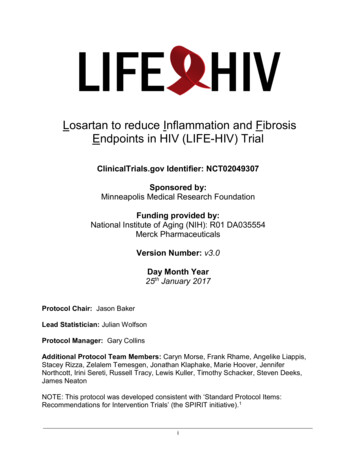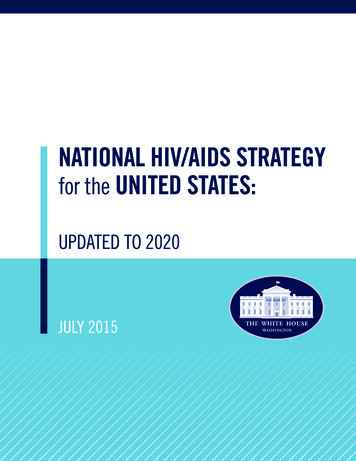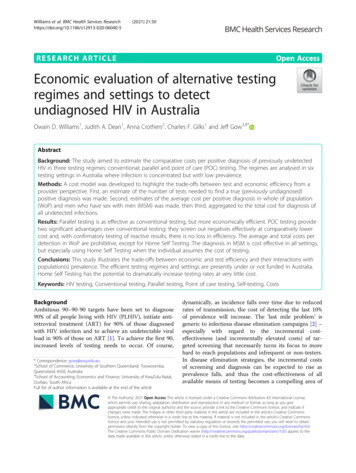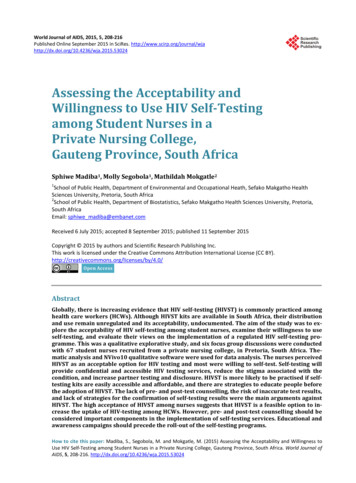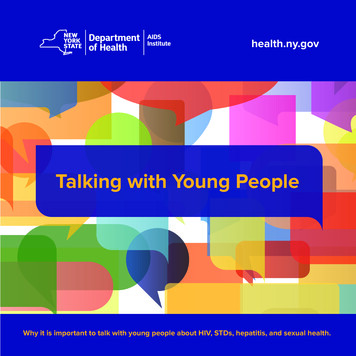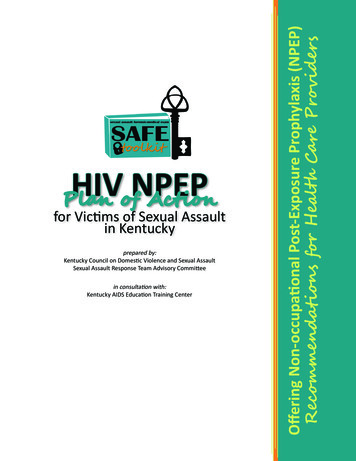
Transcription
for Victims of Sexual Assaultin Kentuckyprepared by:Kentucky Council on Domestic Violence and Sexual AssaultSexual Assault Response Team Advisory Committeein consultation with:Kentucky AIDS Education Training CenterOffering Non-occupational Post-Exposure Prophylaxis (NPEP)Recommendations for Health Care ProvidersHIVNPEPPlan of Action
2Acknowledgements3Introduction5Who Should be Offered NPEP6Who Should Not be Offered NPEP7Exposure Characteristics & Indications Table8NPEP Interventions Table9Action Steps for NPEPAction 1:Action 2:Action 3:Action 4:Action 5:Table ofContentsEvaluation .9Risk Assessment .9-11Source Assessment .12Treatment .12-16Follow up/Referral .1713Treatment Recommendation Table13-14Medication Fact Sheet15HIV Testing & ReferralsBilling Information16Other Laboratory Testing17Summary Overview for Other Service ProvidersPharmacy Considerations .17-18Rape Crisis Center Advocate Considerations.18-20Clinical Infrastructure Considerations.2021Clinical Training Resources / List of Ryan White ClinicsSAMPLE FORMS/APPENDIXSF-A: SAMPLE DISCHARGE INSTRUCTIONS - GENERALSF-B: SAMPLE DISCHARGE INSTRUCTIONS - NPEP SPECIFICSF-C: SAMPLE FOLLOW-UP CARE REFERRAL FORMSF-D: SAMPLE PATIENT INFORMATION SHEETMAP OF RAPE CRISIS CENTERS IN KENTUCKYREFERENCES
The Sexual Assault Response TeamAdvisory CommitteeThe Sexual Assault Response Team Advisory Committee operates pursuant to KRS 403.707with membership representing the following:Kentucky State Police, Co-ChairKentucky Association of Sexual Assault Programs, Co-ChairKentucky Board of NursingKentucky Nurses AssociationKentucky Hospital AssociationKentucky State Police Forensic LaboratoriesCHFS, Family Violence Prevention BranchOffice of Victims Advocacy, Office of the Attorney GeneralSexual Assault Nurse Examiner, Physician, Prosecuting Attorney,and SART Team MemberNPEP Subcommittee of the SART Advisory CommitteeSpecial Thanks to the following individuals for their invaluable contributions on this project:Ruth Collins-WillardKim DeesMelissa EdlinFarrah GuerrantRhonda HenryJeanne KeenMissy RittingerLinda SpurlockLana StephensEmily TamasMaryLee UnderwoodWith Special Thanks to:Crime Victims Compensation BoardThe Kentucky AIDS Education Training CenterUK Chandler Medical CenterAlice C. Thornton, MD, Program DirectorJennifer D. Edwards, Program CoordinatorBrian Murphy, MD, MPH, Program EducatorLisa Graham, PA-C, Program EducatorFrank Romanelli, PharmD, MPH, BCPS, Program EducatorMary Bishop, RPh, Program ConsultantArdis Hoven, MD, Former Program DirectorMolly Turner Loyer, MPH, Former Program Coordinator2
INTRODUCTION.Contracting Human Immunodeficiency Virus (HIV) as aresult of sexual violence isan overwhelming fear formany victims. This documentpresents a plan of action toenable healthcare providersto address this fear. Postexposure prophylaxis fornon-occupational exposures(NPEP) involves the provisionof antiretroviral medicationsto prevent HIV transmission.The risk of HIV transmissionwith some non-occupationalexposures may be similaror of higher risk than withoccupational exposures.Though the risk of HIVinfection is not new, statewideefforts to address HIV nonoccupational post exposureprophylaxis (NPEP) for victimsof sexual assault are relativelyyoung. These efforts haveemerged in the wake of twocritical policy developments:1) the U.S. Department ofHealth and Human Servicesguidelines have been updatedto endorse universal provisionof NPEP for those patientswith reported sexual assault,and 2) Kentucky’s Office ofthe Attorney General (OAG)subsequentlyissuedanOpinion stating that HIV NPEPis a part of basic treatment forsexual assault victims, and assuch, must be paid for by statefunds administered by theCrime Victims CompensationBoard.In response to those updates,the Sexual Assault ResponseTeam Advisory Committee, inconjunction with the KentuckyAIDS Education Training Center,and other professionals acrossthe Commonwealth, producedthis Plan of Action for theprovision of NPEP in regard tothose individuals seeking careafter sexual assault.These recommendations aredesigned to provide guidanceto health care providers whoare managing potential nonoccupational HIV exposuresthat occur as a result of sexualassault. The focus is on thefollowing areas: Deciding who shouldbe offered NPEP basedupon the details of theexposure;Deciding whatmedications and servicesto provide; andDetermining how toprovide these medicationsand services.Organization and Use of thisDocument.The document contains thekey elements regarding nonoccupational post exposureprophylaxis (NPEP) use andshould be used as a quickreference only.Frequentchanges in standards of HIVcare require that the treatmentguidelinesbecarefullyreviewed by the medical teamin your facility to assure that3they conform to acceptablelocal and current approaches.Medical treatment updatesare posted frequently toseveral websites, includingthe http://www.aidsinfo.nih.gov and www.cdc.gov site. Itis recommended that everyprovider be familiar with allrelevant guidelines.The documents and formscontained in this documentmay be reproduced foruse. Please note that thesetreatment recommendationsare not intended to replaceclinical research literatureor current United StatesPublic Health Service (USPHS)guidelines, and may notinclude the full range oftreatment options for allpatients.It is recommended that aprovider contact the KentuckyAIDS Education and TrainingCenter (KY AETC) warmlineor UKMD line and ask forthe infectious disease (ID)physician on call, if thereare questions regarding theprovision of NPEP.Copies of this Document.Copies of this document maybe obtained from the KentuckyAssociation of Sexual AssaultPrograms’ website:www.kasap.org or by calling502-226-2704.
HIVShortcutShortcutCardCardHIVIf you encounter a newly diagnosedHIV patient (through sexual assaultor otherwise) make appropriateregional referral.1.)To consult on HIV care with an ID specialist or pharmacist:1. To ConsultHIVcareLine:with an ID specialistor pharmacistCall KY onAETCWarm866.777.9969UK MD Warm(24/7): Line:859.257.6845Call CallKY AETC866.777.9969Call UK MD (24/7):866.257.68452.)To refer a new HIV patient to care:2. To referanewHIVpatienttocare:Lexington ucah Area:270.444.8183HendersonArea:270.826.02003.)To discuss Clinical Trials available for HIV:3. To discussClinical Trialsavailable for HIV:Call:859.323.6327Call:859.323.6327Kentucky AIDS Education Training CenterChandler Medical Center, MN672Lexington, Kentucky 40536(P) 859.323.9969 (F) 859.323.8926KentuckyAIDS Education TrainingOnline: www.mc.uky.edu/kyaetcCenterChandler Medical Center, MN672Lexington, Kentucky 40536(P) 859.323.9969 (F) 859.323.8826Online: www.mc.uky.edu/kyaetcDefinitions.Non-occupational exposure is any direct mucosal,percutaneous or intravenous contact withpotentially infectious body fluids that occurs outsideperinatal or occupational s(NPEP) is the provision of medications or treatmentto prevent the transmission of a disease or illnessfollowing any direct mucosal, percutaneous orintravenous contact with potentially infectious bodyfluids that occurs outside perinatal or occupationalsituations.Post-exposure Prophylaxis (PEP) is the provision ofmedications or treatment to prevent transmissionof a disease or illness following an occupational orperinatal exposure.4
WHO SHOULD BE OFFERED NPEP?NPEP should be offered to HIV uninfected orunknown status individuals presenting within72 hours of a potential exposure to HIV. It is theresponsibility of the health care provider to helpthe patient who is seeking NPEP to realisticallyassess his/her risk of acquiring HIV infection, tomanage their emotional reactions, and to make aninformed decision about taking NPEP. Assessing the likelihood of HIV infection & HIVstatus following exposure includes two factors: 1. Did a potentially infectious body fluid from theexposure source come into contact with theexposed individual’s mucous membrane ornon-intact skin?Receptive anal intercourse(1-3% per- contact transmission risk)Shared injection drug use equipment(0.67% per-contact transmission risk)Insertive anal intercourse(0.1 – 1% per-contact transmission risk).Receptive vaginal intercourse(0.1 - 1% per-contact transmission risk).Insertive vaginal intercourse(less than 0.1 % per-contact transmission risk).Other potentially infectious body fluid on amucous membrane or non-intact skin.Receptive oral intercourse with ejaculation(case reports only: consider NPEP).Assessing the Likelihood that the Source ofExposure is HIV-Infected.In all cases of sexual assault, NPEP should beconsidered. It is reasonable to offer NPEP toindividuals following sexual assault by unknownassailant. It is also reasonable to offer NPEP forwomen who have been sexually assaulted bymen who are known to them, but whose sexualand injection drug use history is not knownwith confidence. Multiple other factors can beconsidered to determine the likelihood that thesource of exposure is HIV-infected.-AND2. Is the exposure source known to be HIVinfected or at risk of having HIV infection?Individuals at highest risk of acquiring HIV infectionfrom their specific exposure are expected to benefitmost from NPEP. Potentially exposed individualsshould be assisted in evaluating their risk basedupon the type of sexual contact or other exposure,and the likelihood that the exposure source is HIVinfected.Assessing the Risk of the Exposure.If a potentially infectious body fluid (e.g., bloodor blood products, genital secretions, peritoneal,pleural or cerebrospinal fluids but NOT saliva,tears, or sweat) was in contact with a mucousmembrane (e.g., eye, oral, nasal, or genital mucosa)or non-intact skin (punctures, cut, or substantiallyabraded), infection is possible and consideration ofNPEP is warranted.Individuals at highestrisk of acquiring HIVinfection from theirspecific exposure areexpected to benefitmost from NPEPThe following activities are associated with HIVtransmission risk. Note that additional factorsthat might enhance sexual transmission, such astrauma, genital ulcer disease, or cervical ectopy,should also be considered:5
There is a growing incidence of HIV infection amongthe female sex partners of intravenous drug users(IDUs) or men who deny having sex with men,particularly in some African American and Latinocommunities. Local demographics may also betaken into consideration. Determining the level ofconfidence regarding the source’s description ofHIV status is a shared task of the patient and healthcare provider.Source Plasma Viral LoadAn undetected or low plasma HIV RNA level or plasmaviral load does not ensure that genital secretions arenot infectious, due to viral compartmentalization.Source HIV TestingIf an exposure source of unknown HIV status isavailable and consents, then HIV testing of thesource should be encouraged, using a rapid orstandard HIV antibody test. If a rapid test is negativeor nonreactive, NPEP should be deferred unlessthere is a high index of suspicion that the sourcemay be in the seronegative window period ofinfection. The seronegative window is on averagefrom 3 to 6 months following time of exposure. Ifusing a confirmatory test, NPEP can be discontinuedwhen the results come back with the same caveat.Multiple ExposuresSome individuals will present for NPEP following aseries of exposures, some of which are within, andothers outside, the 72 hours cut-off. It will be up tothe judgment of the individual health care providerto determine when NPEP should be offered andwhen it should not be offered in such circumstances.It is not unreasonable to offer NPEP, however, thereduced likelihood of being able to prevent HIVinfection because of the earlier exposures shouldbe explained to the patient.Assessing HIV StatusAll individuals presenting for NPEP should beevaluated for the likelihood of pre-existing HIVinfection. The following information should beobtained: 1) if patient has ever been tested, ifso, date of last HIV test, and 2) the number andtype of unprotected exposures since the lasttest. The likelihood of pre-existing HIV infection6should be reviewed with the patient prior to NPEPprescription. If pre-existing HIV infection is likely,this information should be integrated into the riskbenefit assessment when the patient is decidingabout using NPEP. In addition, if the likelihood ofpre-existing HIV infection is high, a three-drugregimen should be considered.WHO SHOULD NOT BE OFFERED NPEP?NPEP is not indicated for perceived exposures ofnegligible or no conceivable risk (e.g., kissing, oralanal contact, mutual masturbation without skinbreakdown, bites not involving blood, cunnilingusnot involving blood exposure, unprotected receptiveoral intercourse without ejaculation {although preejaculate in the presence of oral pathology maycarry some risk}, unprotected insertive oral sex,etc.). Clinicians should be willing to decline requestsfor NPEP and provide supportive counseling andreferrals in these situations. In some situations(e.g., a needle stick from a discarded syringe) therisk is simply not known, and individual judgmentmust be used.Children and AdolescentsThese guidelines do not specifically address thespecial needs of children and adolescents.Refer to local policy of Children’s Hospital or contactyour local Children’s Advocacy Center.PregnancyPregnant women can receive NPEP, but shouldnot be given Efavirenz or didanosine. Also, do notcombine didanosine and stavudine.For more information about antiretroviral use inpregnancy, refer to the Public Health Service TaskForce Recommendations for the Use of AntiretroviralDrugs in Pregnant Women Infected with HIV-1 forMaternal Health and for Reducing Peri-natal HIV-1Transmission in the United States at:http://www.aidsinfo.nih.gov/guidelines/Other Community ExposureThis document is solely for the setting of sexualassault. For other community exposures, refer tothe current CDC NPEP guidelines. www.cdc.gov
Timing of NPEP Initiation.Initiate NPEP as early as possible after the exposure.According to animal models of the natural historyof HIV acquisition following exposure and of NPEPinterventions, NPEP will be more effective thesooner it is started. After initial evaluation thepatient may be given a 7-day starter pack.1) the development of drug resistance if a regimenis used and it is not fully suppressive; 2) the risk offurther development of resistance if resistant viruswas transmitted; and 3) the emotional difficultypatients may have discontinuing medication onceit has been started if they do become HIV infected.Evidence suggests a 72-hour time limit for theinitiation of NPEP. Risks of providing NPEP afterthe 72-hour limit of likely effectiveness include:There is no human evidence that suggest thatNPEP alters the natural history of breakthroughinfections.Exposure Characteristics and Indications for NPEPTABLE 1Exposure CharacteristicOffer NPEP:1. TimingAs soon as possible, and no later than 72 hours following exposure.- AND IF -2. Exposure type Receptive anal intercourse; orInsertive anal intercourse; orReceptive vaginal intercourse; orInsertive vaginal intercourse; orOther potentially infectious body fluid contact on amucous membrane or non-intact skin; orReceptive oral intercourse with ejaculation (considerdue to lower risk; if oral pathology, risk is higher); orShared injection drug use equipment- AND IF 3. Exposure source if knownHIV testing should be a routine part of medical care for allindividuals aged 13-64, no matter the risk factors identified.For those individuals determined to have risk factors, repeatHIV testing should be conducted annually.[CDC Guidelines. 2006.] 7Known HIV-infected; orMen who have sex with men (MSM) of unknownHIV status; orInjection drug user (IDU) or unknown HIV status; orAnonymous (consider); orKnown but with unknown HIV status and risk factorhistory (consider)
NPEP InterventionsTABLE 2ComponentMedicationsRecommended Medication regimen› Preferred regimen consists of two nucleoside analogues zidovudineand lamivudine (coformulated as Combivir) plus a boosted proteaseinhibitor lopinavir and ritonavir (coformulated as Kaletra).If the exposure source’s medication history is accessible, obtain expertantiretroviral resistance consultation immediately. If local consultationis unavailable, call the National HIV Telephone Consultation Service at(800) 933.3413. The hours are: 6 a.m. – 5 p.m., Pacific Standard Time(PST), Monday – Friday. Note that this service is available for health careproviders only. Consider academic hospital infectious disease consultationafter hours.Duration of therapy Testing and interventions 28 DaysInitial exam (day 1 of treatment): CBC, CMP, HIV, Hepatitis B testing,provision of 7 day starter pack and 28 days of anti-nausea medication Follow up (prior to day 8): Office visit, Western Blot HIV test, provisionof HIV medication for days 8-14. Follow up (prior to day 14): Office visit, CBC, CMP, and pregnancy test,and provision of final 14 days of HIV medication. Follow up (at or around day 28): Office visit, final CBC and CMP.Follow-up HIV counseling and testing BaselineSix weeksThree monthsSix monthsPatient Education and ReferralsMedication adherence counselingRisk-reduction counselingReferrals for substance use and mental health treatment as appropriate In all cases of sexual assault,NPEP should be considered.8
ACTION STEPS FOR HIV NPEPNPEP Action 1: EVALUATIONEvaluation for the exposed patient should be treated with the highest level of confidentiality.HIV reporting should take place as required by state laws.Circumstances of the exposure and NPEP management should be recorded in the medical record.Details should include: Date and time of exposure (is it within 72-hours?) Details of the incident-where and how exposure occurred, exposure sites on body Details of the exposure: type and amount of fluid or material, severity of exposure Details about exposure source, if available:- HIV, Hepatitis B and Hepatitis C status- If the source is HIV-infected, determine the stage of disease, HIV viral load, current andprevious antiretroviral therapy and antiretroviral resistance information Details about the exposed patient:- Hepatitis A and Hepatitis B vaccination and vaccine-response status- Other medical conditions, drug allergies, and medications- Pregnancy and breast-feeding statusManagement of potential exposures requires a baseline evaluation. The following baseline testsare recommended: Screening and prophylaxis for other STIs Consider serological testing for Hepatitis B and Hepatitis C and Hepatitis B vaccination Pregnancy testing, as appropriate Assess need for emergency hormonal contraceptionNPEP Action 2: RISK ASSESSMENTThe exposure should be evaluated for potential to transmit HIV based on (1) the type of bodysubstance involved, (2) the route, and (3) HIV status of the source patient. Refer to following algorithm for risk assessment.9
GUIDELINES FOR OFFERING HIV NPEP TO PATIENTS OF SEXUAL ASSAULTDid a sexual, percutaneous, or other significant exposure topotentially HIV-infected fluid occur?NO(See Table 1 on back)NPEP NOT RECOMMENDED.No follow-up neededYESWas exposure anisolated event?NOYESTime since exposure 72 Hours?NOIf exposure is a result of repeated high-risk behavior (prior consensual/unprotected contact with perpertrator, multiple sex partners, IV drug use,unprotected sex, etc.), consider potential medication toxicity, adherence,resistence, and cost before proceeding. Consider referral to primary carephysician.NPEP is not indicated1; however HIV testing andfollow up evaluation are indicated.YESIs the source available anddoes the source consent tobe tested?NOYESYESIs the source HIV infectedas determined by rapidtesting?NOIs the source assessed to be high risk2?*SEE SOURCE RISK DETERMINATION ON BACK*YESUNSURENONPEP not indicated:follow is required.Patient commits to28 day regimenNPEP not indicated:follow is required.YESINITIATE NPEP3Perform baseline lab testsSource’s serologic test is comfirmed HIVNegative and there is no evidence of acuteretroviral syndrome in the sourceSerology of source is unable to be obtained, or source’s serologic test isconfirmed HIV positive or indeterminate, or there is evidence of acuteretroviral syndrome in the sourceSTOPNPEPCONTINUE NPEP1. Decisions should be individualized, weighing the likelihood of transmission against the potential benefits andrisks of treatment.2. In sexual assault the decision to initiate NPEP is based on whether a significant exposure has occurred ratherthan on the risk behavior of the alleged assailant.3. If the patient is too distraught to engage in a discussion about and/or commitment to the drug regimen atthe initial assessment, the clinician should offer a first dose of the medication and make arrangements for afollow-up within 24 hours to further discuss the indications for NPEP.Modified from New York State Department of Health AIDS Institute www.hivguidelines.org10
Guidelines for Offering HIV Post Exposure Prophylaxis (PEP) to patients of Sexual AssaultTABLE 1Types of Exposure That Do Not Warrant NPEP KissingOral-to-Oral contact without mucosal damageHuman bites not involving bloodExposure to needles or sharps not in contactwith an HIV-infected or at risk personMutual masturbation without skin breakdownOral-anal contactReceptive penile-oral contact withoutejaculationInsertive penile-oral contactOral-vaginal contact without blood exposure Types of Exposure That Should PromptConsideration of NPEPUnprotected receptive and insertive vaginalor anal intercourse with a source that is HIVinfected or at risk for HIV infectionUnprotected receptive penile-oral contact withejaculation with a source that is HIV-infectedor at risk for HIV infectionOral-vaginal contact with blood exposureNeedle sharing with a source known to be HIVinfected or at risk for HIV infectionInjuries with exposure to blood from a sourceknown to be HIV-infected or at risk for HIVinfection (including needle sticks, human bites,accidents)**SOURCE THAT MAY HAVE INCREASED RISK FOR HIV INFECTION**Sources with a history of multiple sex partnersSources with a sexually transmitted disease, particularly ulcerative diseasesSources who are men who have sex with menSources with a history of needle-sharing behaviorSources with a history of trading sex for money and/or drugsPatient Name:Account Number:Date: Pt. commits to 28 day treatmentStarter pack givenPatient declinedTreatment education givenPt. verbalizes understandingPatient referred to:RN or MD signatureModified from New York State Department of Health AIDS Institutewww.hivguidelines.org11
NPEP Action 3: SOURCE ASSESSMENTEvaluate the exposure source only if known/availableKnown HIV infection Obtain history of antiretroviral medication, recentviral load, CD4 cell count, and date of results Consider evaluation and testing for other sexuallytransmitted infections, including Hepatitis B andHepatitis CUnknown HIV infection Obtain risk history and rapid HIV test Consider evaluation and testing for other sexuallytransmitted infections, including Hepatitis B andHepatitis CRegardless of HIV status, assess and assist with access to medical care, social support services,and risk reduction counseling.PleaseNoteTreatment of the patient is prioritized. Treatment should notbe delayed while waiting for lab results. All exposures sustainedduring sexual assault should be considered a risk for HIV transmission.NPEP Action 4: TREATMENTIf (1) the exposure is within 72-hour, (2) the exposure is assessed as a risk by the health care provider,and (3) the patient consents to 28 days of NPEP treatment the following is needed: Consent for HIV testing and NPEP treatment Documentation of patient education regarding testing and treatment course of action Complete blood count with differential Serum liver enzymes Blood urea nitrogen/creatinine UrinalysisA 7 day starter pack with the preferred regimen will be provided at time of initial evaluation.Medications can then be changed at follow up if appropriate based on source patient resistance (ifavailable), efficacy data, toxicity, pill burden/ease of dosing, potential drug interactions, cost, andpregnancy risk. Prophylactic antiemetic and antidiarrhea agents can be used if necessary.Practitioner consultation with a specialist is recommended. UK MD (24/7): 859.257.6845 Centers for Disease Control (CDC) HOTLINE: 1.800.232.4636 NPEP HOTLINE 1.888.448.4911NOTE:If consultation is not immediately available, NPEP should not be delayed; changes can be made as neededafter NPEP has been initiated. If source is found to be HIV negative or nonreactive, NPEP should bediscontinued. Delaying NPEP therapy in order to obtain resistance test results (genotyping or phenotyping)for the purposes of selecting more specific therapy is not advised.Exposed persons are frequently unable to complete NPEP regimens due to side effects. Providing prophylacticsymptom management can improve adherence.12
SPECIFIC TREATMENT RECOMMENDATION: 7-DAY STARTER PACKPreferredA protease inhibitor based regimen with two nucleoside analogues:RegimenLopinavir / ritonavir (coformulated as Kaletra)plusLamivudine and zidovudine (coformulated as Combivir) Alternative regimens may be used if indicated by reaction or other medical indicator.See CDC recommendations for alternative treatment and obtain expert consulation. NOTE: Efavirenz (EFV) should be avoided in pregnant women and women of childbearing potential. Pregnant women should not be given didanosine. Do not combinedidanosine and stavudine.HIV NPEP Medication FactsheetLength of Therapy and Amount Dispensed The total NPEP treatment is 28 days NPEP should not be administered for less than28 days unless:› The source is determined to be uninfected viaWestern Blot› The exposed individual is determined to be HIVinfected per Western Blot› There are intolerable side effects and no alternativesare available› The exposed individual changes his or her mindabout NPEP after re-examining the risks and benefits Individual health care providers should determine aschedule for dispensing NPEP Dispensing an initial week of medication allows staffto assess symptoms, provide counseling, and receiveinitial HIV test results before dispensing additionalNPEP Dispensing the entire 28-day course could result inwasted medications if side effects warrant changesin medication or the patient decides not to continueNPEPInitial Medication Choices and When to Consult an Expert In the absence of information about the exposuresource’s antiretroviral history, or if source is naïveto the medication, the preferred two-drug regimenis Combvir (ZDV lamivudine)- one pill twice a dayplus Kaletra (250/50) 2 pills twice a day. This is themedication in the 7 day starter pack. If the exposure source’s medication and/or drugresistance history is accessible through health careproviders without expertise in retroviral resistance,should consult an expert immediately If alternate drugs are required, refer to CDCguidelines (www.cdc.gov) in combination with expertconsultation. If local consultation is not available call the NationalHIV Telephone Consultation Service at 800-9333413 (6 am to 5 pm PST, Monday through Friday- forhealthcare providers only) Consider academic hospital infectious diseaseconsultation after hours NPEP medication should not be delayed more than 2to 4 hours while accessing consultation› The starter pack should be initiated if there is adelay.› The medication regimen can be changed once thisinformation is available If one of these drugs is prescribed by a health careprofessional without expertise, an expert should beconsulted regarding side effects Drug interactions are also important with these drugsand a full review of all medication is important13
Managing Side Effects, IncludingMedication Changes Patients should be giveninformation regarding gettingmedical assistance in the case ofside effects Common side effects seen withCombivir include nausea, fatigue,and headaches Common side effects seen withKaletra are diarrhea, fatigue,headache, and nausea. It is not clear how much ofthese symptoms are from themedication or from the emotionalimpact of the situation Taking the pills with food reducesnausea. Anti-emetics and analgesics can beprescribed as indicated. In some cases NPEP regimenmay be modified due to adverseeffects in reference withcurrent guidelines and expertconsultation.Adherence to Medication Adherence to medicationcounseling should be stronglyencouraged to all patients Patients should take a misseddose if it is recognized withinapproximately six hours of whenthe dose was scheduled for a BIDmedication, or 12 hours for a oncea day medication If three or more days are missedconsecutively, the patient shouldbe advised to discontinue NPEPmedication course14Post-Coital Contraception Post-coital contraception shouldbe offered when indicated In order to reduce the cumulativenausea effect of thesemedications, it is suggested thatthe contraceptive be delayed atleast one hour after the initialdose of Combivir Pre-medicating with an antiemetic is an option
HIV TESTINGRapid ELISA Testing HIV testing should be routine, using either rapid orconfirmatory testing Patients seeking NPEP may fall into a high-riskcategory for previous HIV infection› In this setting, the positive rapid HIV test hasa very high positive predictive value and thusdeferring NPEP in individuals with a positive orreactive test is reasonable Individuals testing positive or reactive on a rapidtest should be given the option of initial NPEPpending th
treatment recommendations are not intended to replace clinical research literature or current United States Public Health Service (USPHS) guidelines, and may not include the full range of treatment options for all patients. It is recommended that a provider contact the Kentucky AIDS Education and Training Center (KY AETC) warmline

